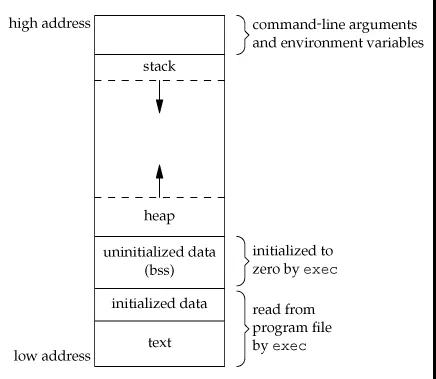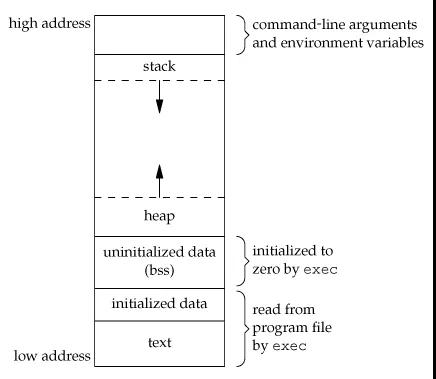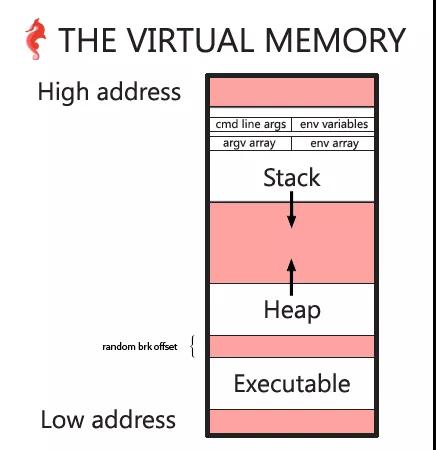本文转载自微信公众号「程序喵大人」,作者程序喵大人 。转载本文请联系程序喵大人公众号。
摊牌了,不装了,其实我是程序喵辛苦工作一天还要回家编辑公众号到大半夜的老婆,希望各位大哥能踊跃转发,完成我一千阅读量的KPI(梦想),谢谢!
咳咳,有点跑题,以下是程序喵的废话,麻烦给个面子划到最后点击在看或者赞,证明我比程序喵人气高,谢谢!
通过/proc文件系统探究虚拟内存
我们会通过/proc文件系统找到正在运行的进程的字符串所在的虚拟内存地址,并通过更改此内存地址的内容来更改字符串内容,使你更深入了解虚拟内存这个概念!这之前先介绍下虚拟内存的定义!
虚拟内存
虚拟内存是一种实现在计算机软硬件之间的内存管理技术,它将程序使用到的内存地址(虚拟地址)映射到计算机内存中的物理地址,虚拟内存使得应用程序从繁琐的管理内存空间任务中解放出来,提高了内存隔离带来的安全性,虚拟内存地址通常是连续的地址空间,由操作系统的内存管理模块控制,在触发缺页中断时利用分页技术将实际的物理内存分配给虚拟内存,而且64位机器虚拟内存的空间大小远超出实际物理内存的大小,使得进程可以使用比物理内存大小更多的内存空间。
在深入研究虚拟内存前,有几个关键点:
- 每个进程都有它自己的虚拟内存
- 虚拟内存的大小取决于系统的体系结构
- 不同操作管理有着不同的管理虚拟内存的方式,但大多数操作系统的虚拟内存结构如下图:
virtual_memory.png
上图并不是特别详细的内存管理图,高地址其实还有内核空间等等,但这不是这篇文章的主题。从图中可以看到高地址存储着命令行参数和环境变量,之后是栈空间、堆空间和可执行程序,其中栈空间向下延申,堆空间向上增长,堆空间需要使用malloc分配,是动态分配的内存的一部分。
首先通过一个简单的C程序探究虚拟内存。
- #include <stdlib.h>
- #include <stdio.h>
- #include <string.h>
- /**
- * main - 使用strdup创建一个字符串的拷贝,strdup内部会使用malloc分配空间,
- * 返回新空间的地址,这段地址空间需要外部自行使用free释放
- *
- * Return: EXIT_FAILURE if malloc failed. Otherwise EXIT_SUCCESS
- */
- int main(void)
- {
- char *s;
- s = strdup("test_memory");
- if (s == NULL)
- {
- fprintf(stderr, "Can't allocate mem with malloc\n");
- return (EXIT_FAILURE);
- }
- printf("%p\n", (void *)s);
- return (EXIT_SUCCESS);
- }
- 编译运行:gcc -Wall -Wextra -pedantic -Werror main.c -o test; ./test
- 输出:0x88f010
我的机器是64位机器,进程的虚拟内存高地址为0xffffffffffffffff, 低地址为0x0,而0x88f010远小于0xffffffffffffffff,因此大概可以推断出被复制的字符串的地址(堆地址)是在内存低地址附近,具体可以通过/proc文件系统验证.
ls /proc目录可以看到好多文件,这里主要关注/proc/[pid]/mem和/proc/[pid]/maps
mem & maps
- man proc
- /proc/[pid]/mem
- This file can be used to access the pages of a process's memory through open(2), read(2), and lseek(2).
- /proc/[pid]/maps
- A file containing the currently mapped memory regions and their access permissions.
- See mmap(2) for some further information about memory mappings.
- The format of the file is:
- address perms offset dev inode pathname
- 00400000-00452000 r-xp 00000000 08:02 173521 /usr/bin/dbus-daemon
- 00651000-00652000 r--p 00051000 08:02 173521 /usr/bin/dbus-daemon
- 00652000-00655000 rw-p 00052000 08:02 173521 /usr/bin/dbus-daemon
- 00e03000-00e24000 rw-p 00000000 00:00 0 [heap]
- 00e24000-011f7000 rw-p 00000000 00:00 0 [heap]
- ...
- 35b1800000-35b1820000 r-xp 00000000 08:02 135522 /usr/lib64/ld-2.15.so
- 35b1a1f000-35b1a20000 r--p 0001f000 08:02 135522 /usr/lib64/ld-2.15.so
- 35b1a20000-35b1a21000 rw-p 00020000 08:02 135522 /usr/lib64/ld-2.15.so
- 35b1a21000-35b1a22000 rw-p 00000000 00:00 0
- 35b1c00000-35b1dac000 r-xp 00000000 08:02 135870 /usr/lib64/libc-2.15.so
- 35b1dac000-35b1fac000 ---p 001ac000 08:02 135870 /usr/lib64/libc-2.15.so
- 35b1fac000-35b1fb0000 r--p 001ac000 08:02 135870 /usr/lib64/libc-2.15.so
- 35b1fb0000-35b1fb2000 rw-p 001b0000 08:02 135870 /usr/lib64/libc-2.15.so
- ...
- f2c6ff8c000-7f2c7078c000 rw-p 00000000 00:00 0 [stack:986]
- ...
- 7fffb2c0d000-7fffb2c2e000 rw-p 00000000 00:00 0 [stack]
- 7fffb2d48000-7fffb2d49000 r-xp 00000000 00:00 0 [vdso]
- The address field is the address space in the process that the mapping occupies.
- The perms field is a set of permissions:
- r = read
- w = write
- x = execute
- s = shared
- p = private (copy on write)
- The offset field is the offset into the file/whatever;
- dev is the device (major:minor); inode is the inode on that device. 0 indicates
- that no inode is associated with the memory region,
- as would be the case with BSS (uninitialized data).
- The pathname field will usually be the file that is backing the mapping.
- For ELF files, you can easily coordinate with the offset field
- by looking at the Offset field in the ELF program headers (readelf -l).
- There are additional helpful pseudo-paths:
- [stack]
- The initial process's (also known as the main thread's) stack.
- [stack:<tid>] (since Linux 3.4)
- A thread's stack (where the <tid> is a thread ID).
- It corresponds to the /proc/[pid]/task/[tid]/ path.
- [vdso] The virtual dynamically linked shared object.
- [heap] The process's heap.
- If the pathname field is blank, this is an anonymous mapping as obtained via the mmap(2) function.
- There is no easy way to coordinate
- this back to a process's source, short of running it through gdb(1), strace(1), or similar.
- Under Linux 2.0 there is no field giving pathname.
通过mem文件可以访问和修改整个进程的内存页,通过maps可以看到进程当前已映射的内存区域,有地址和访问权限偏移量等,从maps中可以看到堆空间是在低地址而栈空间是在高地址. 从maps中可以看到heap的访问权限是rw,即可写,所以可以通过堆地址找到上个示例程序中字符串的地址,并通过修改mem文件对应地址的内容,就可以修改字符串的内容啦,程序:
- #include <stdlib.h>
- #include <stdio.h>
- #include <string.h>
- #include <unistd.h>
- /**
- * main - uses strdup to create a new string, loops forever-ever
- *
- * Return: EXIT_FAILURE if malloc failed. Other never returns
- */
- int main(void)
- {
- char *s;
- unsigned long int i;
- s = strdup("test_memory");
- if (s == NULL)
- {
- fprintf(stderr, "Can't allocate mem with malloc\n");
- return (EXIT_FAILURE);
- }
- i = 0;
- while (s)
- {
- printf("[%lu] %s (%p)\n", i, s, (void *)s);
- sleep(1);
- i++;
- }
- return (EXIT_SUCCESS);
- }
- 编译运行:gcc -Wall -Wextra -pedantic -Werror main.c -o loop; ./loop
- 输出:
- [0] test_memory (0x21dc010)
- [1] test_memory (0x21dc010)
- [2] test_memory (0x21dc010)
- [3] test_memory (0x21dc010)
- [4] test_memory (0x21dc010)
- [5] test_memory (0x21dc010)
- [6] test_memory (0x21dc010)
- ...
这里可以写一个脚本通过/proc文件系统找到字符串所在位置并修改其内容,相应的输出也会更改。
首先找到进程的进程号
- ps aux | grep ./loop | grep -v grep
- zjucad 2542 0.0 0.0 4352 636 pts/3 S+ 12:28 0:00 ./loop
2542即为loop程序的进程号,cat /proc/2542/maps得到
- 00400000-00401000 r-xp 00000000 08:01 811716 /home/zjucad/wangzhiqiang/loop
- 00600000-00601000 r--p 00000000 08:01 811716 /home/zjucad/wangzhiqiang/loop
- 00601000-00602000 rw-p 00001000 08:01 811716 /home/zjucad/wangzhiqiang/loop
- 021dc000-021fd000 rw-p 00000000 00:00 0 [heap]
- 7f2adae2a000-7f2adafea000 r-xp 00000000 08:01 8661324 /lib/x86_64-linux-gnu/libc-2.23.so
- 7f2adafea000-7f2adb1ea000 ---p 001c0000 08:01 8661324 /lib/x86_64-linux-gnu/libc-2.23.so
- 7f2adb1ea000-7f2adb1ee000 r--p 001c0000 08:01 8661324 /lib/x86_64-linux-gnu/libc-2.23.so
- 7f2adb1ee000-7f2adb1f0000 rw-p 001c4000 08:01 8661324 /lib/x86_64-linux-gnu/libc-2.23.so
- 7f2adb1f0000-7f2adb1f4000 rw-p 00000000 00:00 0
- 7f2adb1f4000-7f2adb21a000 r-xp 00000000 08:01 8661310 /lib/x86_64-linux-gnu/ld-2.23.so
- 7f2adb3fa000-7f2adb3fd000 rw-p 00000000 00:00 0
- 7f2adb419000-7f2adb41a000 r--p 00025000 08:01 8661310 /lib/x86_64-linux-gnu/ld-2.23.so
- 7f2adb41a000-7f2adb41b000 rw-p 00026000 08:01 8661310 /lib/x86_64-linux-gnu/ld-2.23.so
- 7f2adb41b000-7f2adb41c000 rw-p 00000000 00:00 0
- 7ffd51bb3000-7ffd51bd4000 rw-p 00000000 00:00 0 [stack]
- 7ffd51bdd000-7ffd51be0000 r--p 00000000 00:00 0 [vvar]
- 7ffd51be0000-7ffd51be2000 r-xp 00000000 00:00 0 [vdso]
- ffffffffff600000-ffffffffff601000 r-xp 00000000 00:00 0 [vsyscall]
看见堆地址范围021dc000-021fd000,并且可读可写,而且021dc000<0x21dc010<021fd000,这就可以确认字符串的地址在堆中,在堆中的索引是0x10(至于为什么是0x10,后面会讲到),这时可以通过mem文件到0x21dc010地址修改内容,字符串输出的内容也会随之更改,这里通过python脚本实现此功能。
- #!/usr/bin/env python3
- '''
- Locates and replaces the first occurrence of a string in the heap
- of a process
- Usage: ./read_write_heap.py PID search_string replace_by_string
- Where:
- - PID is the pid of the target process
- - search_string is the ASCII string you are looking to overwrite
- - replace_by_string is the ASCII string you want to replace
- search_string with
- '''
- import sys
- def print_usage_and_exit():
- print('Usage: {} pid search write'.format(sys.argv[0]))
- sys.exit(1)
- # check usage
- if len(sys.argv) != 4:
- print_usage_and_exit()
- # get the pid from args
- pid = int(sys.argv[1])
- if pid <= 0:
- print_usage_and_exit()
- search_string = str(sys.argv[2])
- if search_string == "":
- print_usage_and_exit()
- write_string = str(sys.argv[3])
- if search_string == "":
- print_usage_and_exit()
- # open the maps and mem files of the process
- maps_filename = "/proc/{}/maps".format(pid)
- print("[*] maps: {}".format(maps_filename))
- mem_filename = "/proc/{}/mem".format(pid)
- print("[*] mem: {}".format(mem_filename))
- # try opening the maps file
- try:
- maps_file = open('/proc/{}/maps'.format(pid), 'r')
- except IOError as e:
- print("[ERROR] Can not open file {}:".format(maps_filename))
- print(" I/O error({}): {}".format(e.errno, e.strerror))
- sys.exit(1)
- for line in maps_file:
- sline = line.split(' ')
- # check if we found the heap
- if sline[-1][:-1] != "[heap]":
- continue
- print("[*] Found [heap]:")
- # parse line
- addr = sline[0]
- perm = sline[1]
- offset = sline[2]
- device = sline[3]
- inode = sline[4]
- pathname = sline[-1][:-1]
- print("\tpathname = {}".format(pathname))
- print("\taddresses = {}".format(addr))
- print("\tpermisions = {}".format(perm))
- print("\toffset = {}".format(offset))
- print("\tinode = {}".format(inode))
- # check if there is read and write permission
- if perm[0] != 'r' or perm[1] != 'w':
- print("[*] {} does not have read/write permission".format(pathname))
- maps_file.close()
- exit(0)
- # get start and end of the heap in the virtual memory
- addr = addr.split("-")
- if len(addr) != 2: # never trust anyone, not even your OS :)
- print("[*] Wrong addr format")
- maps_file.close()
- exit(1)
- addr_start = int(addr[0], 16)
- addr_end = int(addr[1], 16)
- print("\tAddr start [{:x}] | end [{:x}]".format(addr_start, addr_end))
- # open and read mem
- try:
- mem_file = open(mem_filename, 'rb+')
- except IOError as e:
- print("[ERROR] Can not open file {}:".format(mem_filename))
- print(" I/O error({}): {}".format(e.errno, e.strerror))
- maps_file.close()
- exit(1)
- # read heap
- mem_file.seek(addr_start)
- heap = mem_file.read(addr_end - addr_start)
- # find string
- try:
- i = heap.index(bytes(search_string, "ASCII"))
- except Exception:
- print("Can't find '{}'".format(search_string))
- maps_file.close()
- mem_file.close()
- exit(0)
- print("[*] Found '{}' at {:x}".format(search_string, i))
- # write the new string
- print("[*] Writing '{}' at {:x}".format(write_string, addr_start + i))
- mem_file.seek(addr_start + i)
- mem_file.write(bytes(write_string, "ASCII"))
- # close files
- maps_file.close()
- mem_file.close()
- # there is only one heap in our example
- break
运行这个Python脚本
- zjucad@zjucad-ONDA-H110-MINI-V3-01:~/wangzhiqiang$ sudo ./loop.py 2542 test_memory test_hello
- [*] maps: /proc/2542/maps
- [*] mem: /proc/2542/mem
- [*] Found [heap]:
- pathname = [heap]
- addresses = 021dc000-021fd000
- permisions = rw-p
- offset = 00000000
- inode = 0
- Addr start [21dc000] | end [21fd000]
- [*] Found 'test_memory' at 10
- [*] Writing 'test_hello' at 21dc010
同时字符串输出的内容也已更改
- [633] test_memory (0x21dc010)
- [634] test_memory (0x21dc010)
- [635] test_memory (0x21dc010)
- [636] test_memory (0x21dc010)
- [637] test_memory (0x21dc010)
- [638] test_memory (0x21dc010)
- [639] test_memory (0x21dc010)
- [640] test_helloy (0x21dc010)
- [641] test_helloy (0x21dc010)
- [642] test_helloy (0x21dc010)
- [643] test_helloy (0x21dc010)
- [644] test_helloy (0x21dc010)
- [645] test_helloy (0x21dc010)
实验成功。
通过实践画出虚拟内存空间分布图
再列出内存空间分布图
基本上每个人或多或少都了解虚拟内存的空间分布,那如何验证它呢,下面会提到。
堆栈空间
首先验证栈空间的位置,我们都知道C中局部变量是存储在栈空间的,malloc分配的内存是存储在堆空间,所以可以通过打印出局部变量地址和malloc的返回内存地址的方式来验证堆栈空间在整个虚拟空间中的位置。
- #include <stdlib.h>
- #include <stdio.h>
- #include <string.h>
- /**
- * main - print locations of various elements
- *
- * Return: EXIT_FAILURE if something failed. Otherwise EXIT_SUCCESS
- */
- int main(void)
- {
- int a;
- void *p;
- printf("Address of a: %p\n", (void *)&a);
- p = malloc(98);
- if (p == NULL)
- {
- fprintf(stderr, "Can't malloc\n");
- return (EXIT_FAILURE);
- }
- printf("Allocated space in the heap: %p\n", p);
- return (EXIT_SUCCESS);
- }
- 编译运行:gcc -Wall -Wextra -pedantic -Werror main.c -o test; ./test
- 输出:
- Address of a: 0x7ffedde9c7fc
- Allocated space in the heap: 0x55ca5b360670
通过结果可以看出堆地址空间在栈地址空间下面,整理如图:
可执行程序
可执行程序也在虚拟内存中,可以通过打印main函数的地址,并与堆栈地址相比较,即可知道可执行程序地址相对于堆栈地址的分布。
- #include <stdlib.h>
- #include <stdio.h>
- #include <string.h>
- /**
- * main - print locations of various elements
- *
- * Return: EXIT_FAILURE if something failed. Otherwise EXIT_SUCCESS
- */
- int main(void)
- {
- int a;
- void *p;
- printf("Address of a: %p\n", (void *)&a);
- p = malloc(98);
- if (p == NULL)
- {
- fprintf(stderr, "Can't malloc\n");
- return (EXIT_FAILURE);
- }
- printf("Allocated space in the heap: %p\n", p);
- printf("Address of function main: %p\n", (void *)main);
- return (EXIT_SUCCESS);
- }
- 编译运行:gcc main.c -o test; ./test
- 输出:
- Address of a: 0x7ffed846de2c
- Allocated space in the heap: 0x561b9ee8c670
- Address of function main: 0x561b9deb378a
由于main(0x561b9deb378a) < heap(0x561b9ee8c670) < (0x7ffed846de2c),可以画出分布图如下:
virtual_memory_stack_heap_executable.png
命令行参数和环境变量
程序入口main函数可以携带参数:
- 第一个参数(argc): 命令行参数的个数
- 第二个参数(argv): 指向命令行参数数组的指针
- 第三个参数(env): 指向环境变量数组的指针
通过程序可以看见这些元素在虚拟内存中的位置:
- #include <stdlib.h>
- #include <stdio.h>
- #include <string.h>
- /**
- * main - print locations of various elements
- *
- * Return: EXIT_FAILURE if something failed. Otherwise EXIT_SUCCESS
- */
- int main(int ac, char **av, char **env)
- {
- int a;
- void *p;
- int i;
- printf("Address of a: %p\n", (void *)&a);
- p = malloc(98);
- if (p == NULL)
- {
- fprintf(stderr, "Can't malloc\n");
- return (EXIT_FAILURE);
- }
- printf("Allocated space in the heap: %p\n", p);
- printf("Address of function main: %p\n", (void *)main);
- printf("First bytes of the main function:\n\t");
- for (i = 0; i < 15; i++)
- {
- printf("%02x ", ((unsigned char *)main)[i]);
- }
- printf("\n");
- printf("Address of the array of arguments: %p\n", (void *)av);
- printf("Addresses of the arguments:\n\t");
- for (i = 0; i < ac; i++)
- {
- printf("[%s]:%p ", av[i], av[i]);
- }
- printf("\n");
- printf("Address of the array of environment variables: %p\n", (void *)env);
- printf("Address of the first environment variable: %p\n", (void *)(env[0]));
- return (EXIT_SUCCESS);
- }
- 编译运行:gcc main.c -o test; ./test nihao hello
- 输出:
- Address of a: 0x7ffcc154a748
- Allocated space in the heap: 0x559bd1bee670
- Address of function main: 0x559bd09807ca
- First bytes of the main function:
- 55 48 89 e5 48 83 ec 40 89 7d dc 48 89 75 d0
- Address of the array of arguments: 0x7ffcc154a848
- Addresses of the arguments:
- [./test]:0x7ffcc154b94f [nihao]:0x7ffcc154b956 [hello]:0x7ffcc154b95c
- Address of the array of environment variables: 0x7ffcc154a868
- Address of the first environment variable: 0x7ffcc154b962
结果如下:
main(0x559bd09807ca) < heap(0x559bd1bee670) < stack(0x7ffcc154a748) < argv(0x7ffcc154a848) < env(0x7ffcc154a868) < arguments(0x7ffcc154b94f->0x7ffcc154b95c + 6)(6为hello+1('\0')) < env first(0x7ffcc154b962)
可以看出所有的命令行参数都是相邻的,并且紧接着就是环境变量。
argv和env数组地址是相邻的吗
上例中argv有4个元素,命令行中有三个参数,还有一个NULL指向标记数组的末尾,每个指针是8字节,8*4=32, argv(0x7ffcc154a848) + 32(0x20) = env(0x7ffcc154a868),所以argv和env数组指针是相邻的.
命令行参数地址紧随环境变量地址之后吗
首先需要获取环境变量数组的大小,环境变量数组是以NULL结束的,所以可以遍历env数组,检查是否为NULL,获取数组大小,代码如下:
- #include <stdlib.h>
- #include <stdio.h>
- #include <string.h>
- /**
- * main - print locations of various elements
- *
- * Return: EXIT_FAILURE if something failed. Otherwise EXIT_SUCCESS
- */
- int main(int ac, char **av, char **env)
- {
- int a;
- void *p;
- int i;
- int size;
- printf("Address of a: %p\n", (void *)&a);
- p = malloc(98);
- if (p == NULL)
- {
- fprintf(stderr, "Can't malloc\n");
- return (EXIT_FAILURE);
- }
- printf("Allocated space in the heap: %p\n", p);
- printf("Address of function main: %p\n", (void *)main);
- printf("First bytes of the main function:\n\t");
- for (i = 0; i < 15; i++)
- {
- printf("%02x ", ((unsigned char *)main)[i]);
- }
- printf("\n");
- printf("Address of the array of arguments: %p\n", (void *)av);
- printf("Addresses of the arguments:\n\t");
- for (i = 0; i < ac; i++)
- {
- printf("[%s]:%p ", av[i], av[i]);
- }
- printf("\n");
- printf("Address of the array of environment variables: %p\n", (void *)env);
- printf("Address of the first environment variables:\n");
- for (i = 0; i < 3; i++)
- {
- printf("\t[%p]:\"%s\"\n", env[i], env[i]);
- }
- /* size of the env array */
- i = 0;
- while (env[i] != NULL)
- {
- i++;
- }
- i++; /* the NULL pointer */
- size = i * sizeof(char *);
- printf("Size of the array env: %d elements -> %d bytes (0x%x)\n", i, size, size);
- return (EXIT_SUCCESS);
- }
- 编译运行:gcc main.c -o test; ./test nihao hello
- 输出:
- Address of a: 0x7ffd5ebadff4
- Allocated space in the heap: 0x562ba4e13670
- Address of function main: 0x562ba2f1881a
- First bytes of the main function:
- 55 48 89 e5 48 83 ec 40 89 7d dc 48 89 75 d0
- Address of the array of arguments: 0x7ffd5ebae0f8
- Addresses of the arguments:
- [./test]:0x7ffd5ebae94f [nihao]:0x7ffd5ebae956 [hello]:0x7ffd5ebae95c
- Address of the array of environment variables: 0x7ffd5ebae118
- Address of the first environment variables:
- [0x7ffd5ebae962]:"LS_COLORS=rs=0:di=01;34:ln=01;36:mh=00:pi=40;33:so=01;35:do=01;35:bd=40;33;01:cd=40;33;01:or=40;31;01:mi=00:su=37;41:sg=30;43:ca=30;41:tw=30;42:ow=34;42:st=37;44:ex=01;32:*.tar=01;31:*.tgz=01;31:*.arc=01;31:*.arj=01;31:*.taz=01;31:*.lha=01;31:*.lz4=01;31:*.lzh=01;31:*.lzma=01;31:*.tlz=01;31:*.txz=01;31:*.tzo=01;31:*.t7z=01;31:*.zip=01;31:*.z=01;31:*.Z=01;31:*.dz=01;31:*.gz=01;31:*.lrz=01;31:*.lz=01;31:*.lzo=01;31:*.xz=01;31:*.zst=01;31:*.tzst=01;31:*.bz2=01;31:*.bz=01;31:*.tbz=01;31:*.tbz2=01;31:*.tz=01;31:*.deb=01;31:*.rpm=01;31:*.jar=01;31:*.war=01;31:*.ear=01;31:*.sar=01;31:*.rar=01;31:*.alz=01;31:*.ace=01;31:*.zoo=01;31:*.cpio=01;31:*.7z=01;31:*.rz=01;31:*.cab=01;31:*.wim=01;31:*.swm=01;31:*.dwm=01;31:*.esd=01;31:*.jpg=01;35:*.jpeg=01;35:*.mjpg=01;35:*.mjpeg=01;35:*.gif=01;35:*.bmp=01;35:*.pbm=01;35:*.pgm=01;35:*.ppm=01;35:*.tga=01;35:*.xbm=01;35:*.xpm=01;35:*.tif=01;35:*.tiff=01;35:*.png=01;35:*.svg=01;35:*.svgz=01;35:*.mng=01;35:*.pcx=01;35:*.mov=01;35:*.mpg=01;35:*.mpeg=01;35:*.m2v=01;35:*.mkv=01;35:*.webm=01;35:*.ogm=01;35:*.mp4=01;35:*.m4v=01;35:*.mp4v=01;35:*.vob=01;35:*.qt=01;35:*.nuv=01;35:*.wmv=01;35:*.asf=01;35:*.rm=01;35:*.rmvb=01;35:*.flc=01;35:*.avi=01;35:*.fli=01;35:*.flv=01;35:*.gl=01;35:*.dl=01;35:*.xcf=01;35:*.xwd=01;35:*.yuv=01;35:*.cgm=01;35:*.emf=01;35:*.ogv=01;35:*.ogx=01;35:*.aac=00;36:*.au=00;36:*.flac=00;36:*.m4a=00;36:*.mid=00;36:*.midi=00;36:*.mka=00;36:*.mp3=00;36:*.mpc=00;36:*.ogg=00;36:*.ra=00;36:*.wav=00;36:*.oga=00;36:*.opus=00;36:*.spx=00;36:*.xspf=00;36:"
- [0x7ffd5ebaef4e]:"HOSTNAME=3e8650948c0c"
- [0x7ffd5ebaef64]:"OLDPWD=/"
- Size of the array env: 11 elements -> 88 bytes (0x58)
- 运算结果如下:
- root@3e8650948c0c:/ubuntu# bc
- bc 1.07.1
- Copyright 1991-1994, 1997, 1998, 2000, 2004, 2006, 2008, 2012-2017 Free Software Foundation, Inc.
- This is free software with ABSOLUTELY NO WARRANTY.
- For details type `warranty'.
- obase=16
- ibase=16
- 58+7ffd5ebae118
- (standard_in) 3: syntax error
- 58+7FFD5EBAE118
- 7FFD5EBAE170
- quit
- 通过结果可知7FFD5EBAE170 != 0x7
通过结果可知7FFD5EBAE170 != 0x7ffd5ebae94f,所以命令行参数地址不是紧随环境变量地址之后。
截至目前画出图表如下:
栈内存真的向下增长吗
可以通过调用函数来确认,如果真的是向下增长,那么调用函数的地址应该高于被调用函数地址, 代码如下:
- #include <stdlib.h>
- #include <stdio.h>
- #include <string.h>
- void f(void)
- {
- int a;
- int b;
- int c;
- a = 98;
- b = 1024;
- c = a * b;
- printf("[f] a = %d, b = %d, c = a * b = %d\n", a, b, c);
- printf("[f] Adresses of a: %p, b = %p, c = %p\n", (void *)&a, (void *)&b, (void *)&c);
- }
- int main(int ac, char **av, char **env)
- {
- int a;
- void *p;
- int i;
- int size;
- printf("Address of a: %p\n", (void *)&a);
- p = malloc(98);
- if (p == NULL)
- {
- fprintf(stderr, "Can't malloc\n");
- return (EXIT_FAILURE);
- }
- printf("Allocated space in the heap: %p\n", p);
- printf("Address of function main: %p\n", (void *)main);
- f();
- return (EXIT_SUCCESS);
- }
- 编译运行:gcc main.c -o test; ./test
- 输出:
- Address of a: 0x7ffefc75083c
- Allocated space in the heap: 0x564d46318670
- Address of function main: 0x564d45b9880e
- [f] a = 98, b = 1024, c = a * b = 100352
- [f] Adresses of a: 0x7ffefc7507ec, b = 0x7ffefc7507f0, c = 0x7ffefc7507f4
结果可知: f{a} 0x7ffefc7507ec < main{a} 0x7ffefc75083c
可画图如下:
其实也可以写一个简单的代码,通过查看/proc文件系统中map内容来查看内存分布,这里就不举例啦。
堆内存(malloc)
malloc
malloc是常用的动态分配内存的函数,malloc申请的内存分配在堆中,注意malloc是glibc函数,不是系统调用。
man malloc:
- [...] allocate dynamic memory[...]
- void *malloc(size_t size);
- [...]
- The malloc() function allocates size bytes and returns a pointer to the allocated memory.
不调用malloc,就不会有堆空间[heap]
看一段不调用malloc的代码
- #include <stdlib.h>
- #include <stdio.h>
- /**
- * main - do nothing
- *
- * Return: EXIT_FAILURE if something failed. Otherwise EXIT_SUCCESS
- */
- int main(void)
- {
- getchar();
- return (EXIT_SUCCESS);
- }
- 编译运行:gcc test.c -o 2; ./2
- step 1 : ps aux | grep \ \./2$
- 输出:
- zjucad 3023 0.0 0.0 4352 788 pts/3 S+ 13:58 0:00 ./2
- step 2 : /proc/3023/maps
- 输出:
- 00400000-00401000 r-xp 00000000 08:01 811723 /home/zjucad/wangzhiqiang/2
- 00600000-00601000 r--p 00000000 08:01 811723 /home/zjucad/wangzhiqiang/2
- 00601000-00602000 rw-p 00001000 08:01 811723 /home/zjucad/wangzhiqiang/2
- 007a4000-007c5000 rw-p 00000000 00:00 0 [heap]
- 7f954ca02000-7f954cbc2000 r-xp 00000000 08:01 8661324 /lib/x86_64-linux-gnu/libc-2.23.so
- 7f954cbc2000-7f954cdc2000 ---p 001c0000 08:01 8661324 /lib/x86_64-linux-gnu/libc-2.23.so
- 7f954cdc2000-7f954cdc6000 r--p 001c0000 08:01 8661324 /lib/x86_64-linux-gnu/libc-2.23.so
- 7f954cdc6000-7f954cdc8000 rw-p 001c4000 08:01 8661324 /lib/x86_64-linux-gnu/libc-2.23.so
- 7f954cdc8000-7f954cdcc000 rw-p 00000000 00:00 0
- 7f954cdcc000-7f954cdf2000 r-xp 00000000 08:01 8661310 /lib/x86_64-linux-gnu/ld-2.23.so
- 7f954cfd2000-7f954cfd5000 rw-p 00000000 00:00 0
- 7f954cff1000-7f954cff2000 r--p 00025000 08:01 8661310 /lib/x86_64-linux-gnu/ld-2.23.so
- 7f954cff2000-7f954cff3000 rw-p 00026000 08:01 8661310 /lib/x86_64-linux-gnu/ld-2.23.so
- 7f954cff3000-7f954cff4000 rw-p 00000000 00:00 0
- 7ffed68a1000-7ffed68c2000 rw-p 00000000 00:00 0 [stack]
- 7ffed690e000-7ffed6911000 r--p 00000000 00:00 0 [vvar]
- 7ffed6911000-7ffed6913000 r-xp 00000000 00:00 0 [vdso]
- ffffffffff600000-ffffffffff601000 r-xp 00000000 00:00 0 [vsyscall]
可以看到,如果不调用malloc,maps中就没有[heap]
下面运行一个带有malloc的程序
- #include <stdio.h>
- #include <stdlib.h>
- /**
- * main - prints the malloc returned address
- *
- * Return: EXIT_FAILURE if something failed. Otherwise EXIT_SUCCESS
- */
- int main(void)
- {
- void *p;
- p = malloc(1);
- printf("%p\n", p);
- getchar();
- return (EXIT_SUCCESS);
- }
- 编译运行:gcc test.c -o 3; ./3
- 输出:0xcc7010
- 验证步骤及输出:
- zjucad@zjucad-ONDA-H110-MINI-V3-01:~/wangzhiqiang$ ps aux | grep \ \./3$
- zjucad 3113 0.0 0.0 4352 644 pts/3 S+ 14:06 0:00 ./3
- zjucad@zjucad-ONDA-H110-MINI-V3-01:~/wangzhiqiang$ cat /proc/3113/maps
- 00400000-00401000 r-xp 00000000 08:01 811726 /home/zjucad/wangzhiqiang/3
- 00600000-00601000 r--p 00000000 08:01 811726 /home/zjucad/wangzhiqiang/3
- 00601000-00602000 rw-p 00001000 08:01 811726 /home/zjucad/wangzhiqiang/3
- 00cc7000-00ce8000 rw-p 00000000 00:00 0 [heap]
- 7fc7e9128000-7fc7e92e8000 r-xp 00000000 08:01 8661324 /lib/x86_64-linux-gnu/libc-2.23.so
- 7fc7e92e8000-7fc7e94e8000 ---p 001c0000 08:01 8661324 /lib/x86_64-linux-gnu/libc-2.23.so
- 7fc7e94e8000-7fc7e94ec000 r--p 001c0000 08:01 8661324 /lib/x86_64-linux-gnu/libc-2.23.so
- 7fc7e94ec000-7fc7e94ee000 rw-p 001c4000 08:01 8661324 /lib/x86_64-linux-gnu/libc-2.23.so
- 7fc7e94ee000-7fc7e94f2000 rw-p 00000000 00:00 0
- 7fc7e94f2000-7fc7e9518000 r-xp 00000000 08:01 8661310 /lib/x86_64-linux-gnu/ld-2.23.so
- 7fc7e96f8000-7fc7e96fb000 rw-p 00000000 00:00 0
- 7fc7e9717000-7fc7e9718000 r--p 00025000 08:01 8661310 /lib/x86_64-linux-gnu/ld-2.23.so
- 7fc7e9718000-7fc7e9719000 rw-p 00026000 08:01 8661310 /lib/x86_64-linux-gnu/ld-2.23.so
- 7fc7e9719000-7fc7e971a000 rw-p 00000000 00:00 0
- 7ffc91c18000-7ffc91c39000 rw-p 00000000 00:00 0 [stack]
- 7ffc91d5f000-7ffc91d62000 r--p 00000000 00:00 0 [vvar]
- 7ffc91d62000-7ffc91d64000 r-xp 00000000 00:00 0 [vdso]
- ffffffffff600000-ffffffffff601000 r-xp 00000000 00:00 0 [vsyscall]
程序中带有malloc,那maps中就有[heap]段,并且malloc返回的地址在heap的地址段中,但是返回的地址却不再heap的最开始地址上,相差了0x10字节,为什么呢?看下面:
strace, brk, sbrk
malloc不是系统调用,它是一个正常函数,它必须调用某些系统调用才可以操作堆内存,通过使用strace工具可以追踪进程的系统调用和信号,为了确认系统调用是malloc产生的,所以在malloc前后添加write系统调用方便定位问题。
- #include <stdio.h>
- #include <stdlib.h>
- #include <unistd.h>
- /**
- * main - let's find out which syscall malloc is using
- *
- * Return: EXIT_FAILURE if something failed. Otherwise EXIT_SUCCESS
- */
- int main(void)
- {
- void *p;
- write(1, "BEFORE MALLOC\n", 14);
- p = malloc(1);
- write(1, "AFTER MALLOC\n", 13);
- printf("%p\n", p);
- getchar();
- return (EXIT_SUCCESS);
- }
- 编译运行:gcc test.c -o 4
- zjucad@zjucad-ONDA-H110-MINI-V3-01:~/wangzhiqiang$ strace ./4
- execve("./4", ["./4"], [/* 34 vars */]) = 0
- brk(NULL) = 0x781000
- access("/etc/ld.so.nohwcap", F_OK) = -1 ENOENT (No such file or directory)
- access("/etc/ld.so.preload", R_OK) = -1 ENOENT (No such file or directory)
- open("/etc/ld.so.cache", O_RDONLY|O_CLOEXEC) = 3
- fstat(3, {st_mode=S_IFREG|0644, st_size=111450, ...}) = 0
- mmap(NULL, 111450, PROT_READ, MAP_PRIVATE, 3, 0) = 0x7f37720fa000
- close(3) = 0
- access("/etc/ld.so.nohwcap", F_OK) = -1 ENOENT (No such file or directory)
- open("/lib/x86_64-linux-gnu/libc.so.6", O_RDONLY|O_CLOEXEC) = 3
- read(3, "\177ELF\2\1\1\3\0\0\0\0\0\0\0\0\3\0>\0\1\0\0\0P\t\2\0\0\0\0\0"..., 832) = 832
- fstat(3, {st_mode=S_IFREG|0755, st_size=1868984, ...}) = 0
- mmap(NULL, 4096, PROT_READ|PROT_WRITE, MAP_PRIVATE|MAP_ANONYMOUS, -1, 0) = 0x7f37720f9000
- mmap(NULL, 3971488, PROT_READ|PROT_EXEC, MAP_PRIVATE|MAP_DENYWRITE, 3, 0) = 0x7f3771b27000
- mprotect(0x7f3771ce7000, 2097152, PROT_NONE) = 0
- mmap(0x7f3771ee7000, 24576, PROT_READ|PROT_WRITE, MAP_PRIVATE|MAP_FIXED|MAP_DENYWRITE, 3, 0x1c0000) = 0x7f3771ee7000
- mmap(0x7f3771eed000, 14752, PROT_READ|PROT_WRITE, MAP_PRIVATE|MAP_FIXED|MAP_ANONYMOUS, -1, 0) = 0x7f3771eed000
- close(3) = 0
- mmap(NULL, 4096, PROT_READ|PROT_WRITE, MAP_PRIVATE|MAP_ANONYMOUS, -1, 0) = 0x7f37720f8000
- mmap(NULL, 4096, PROT_READ|PROT_WRITE, MAP_PRIVATE|MAP_ANONYMOUS, -1, 0) = 0x7f37720f7000
- arch_prctl(ARCH_SET_FS, 0x7f37720f8700) = 0
- mprotect(0x7f3771ee7000, 16384, PROT_READ) = 0
- mprotect(0x600000, 4096, PROT_READ) = 0
- mprotect(0x7f3772116000, 4096, PROT_READ) = 0
- munmap(0x7f37720fa000, 111450) = 0
- write(1, "BEFORE MALLOC\n", 14BEFORE MALLOC
- ) = 14
- brk(NULL) = 0x781000
- brk(0x7a2000) = 0x7a2000
- write(1, "AFTER MALLOC\n", 13AFTER MALLOC
- ) = 13
- fstat(1, {st_mode=S_IFCHR|0620, st_rdev=makedev(136, 3), ...}) = 0
- write(1, "0x781010\n", 90x781010
- ) = 9
- fstat(0, {st_mode=S_IFCHR|0620, st_rdev=makedev(136, 3), ...}) = 0
最后几行的输出可知,malloc主要调用brk系统调用来操作堆内存。
- man brk
- ...
- int brk(void *addr);
- void *sbrk(intptr_t increment);
- ...
- DESCRIPTION
- brk() and sbrk() change the location of the program break, which defines
- the end of the process's data segment (i.e., the program break is the first
- location after the end of the uninitialized data segment). Increasing the
- program break has the effect of allocating memory to the process; decreas‐
- ing the break deallocates memory.
- brk() sets the end of the data segment to the value specified by addr, when
- that value is reasonable, the system has enough memory, and the process
- does not exceed its maximum data size (see setrlimit(2)).
- sbrk() increments the program's data space by increment bytes. Calling
- sbrk() with an increment of 0 can be used to find the current location of
- the program break.
程序中断是虚拟内存中程序数据段结束后的第一个位置的地址,malloc通过调用brk或者sbrk,增加程序中断的值就可以创建新空间来动态分配内存,首次调用brk会返回当前程序中断的地址,第二次调用brk也会返回程序中断的地址,可以发现第二次brk返回地址大于第一次brk返回地址,brk就是通过增加程序中断地址的方式来分配内存,可以看出现在的堆地址范围是0x781000-0x7a2000,通过cat /proc/[pid]/maps也可以验证,此处就不贴上实际验证的结果啦。
多次malloc
如果多次malloc会出现什么现象呢,代码如下:
- #include <stdio.h>
- #include <stdlib.h>
- #include <unistd.h>
- /**
- * main - many calls to malloc
- *
- * Return: EXIT_FAILURE if something failed. Otherwise EXIT_SUCCESS
- */
- int main(void)
- {
- void *p;
- write(1, "BEFORE MALLOC #0\n", 17);
- p = malloc(1024);
- write(1, "AFTER MALLOC #0\n", 16);
- printf("%p\n", p);
- write(1, "BEFORE MALLOC #1\n", 17);
- p = malloc(1024);
- write(1, "AFTER MALLOC #1\n", 16);
- printf("%p\n", p);
- write(1, "BEFORE MALLOC #2\n", 17);
- p = malloc(1024);
- write(1, "AFTER MALLOC #2\n", 16);
- printf("%p\n", p);
- write(1, "BEFORE MALLOC #3\n", 17);
- p = malloc(1024);
- write(1, "AFTER MALLOC #3\n", 16);
- printf("%p\n", p);
- getchar();
- return (EXIT_SUCCESS);
- }
- 编译运行:gcc test.c -o 5; strace ./5
- 摘要输出结果如下:
- write(1, "BEFORE MALLOC #0\n", 17BEFORE MALLOC #0
- ) = 17
- brk(NULL) = 0x561605c7a000
- brk(0x561605c9b000) = 0x561605c9b000
- write(1, "AFTER MALLOC #0\n", 16AFTER MALLOC #0
- ) = 16
- fstat(1, {st_mode=S_IFCHR|0620, st_rdev=makedev(136, 0), ...}) = 0
- write(1, "0x561605c7a260\n", 150x561605c7a260
- ) = 15
- write(1, "BEFORE MALLOC #1\n", 17BEFORE MALLOC #1
- ) = 17
- write(1, "AFTER MALLOC #1\n", 16AFTER MALLOC #1
- ) = 16
- write(1, "0x561605c7aa80\n", 150x561605c7aa80
- ) = 15
- write(1, "BEFORE MALLOC #2\n", 17BEFORE MALLOC #2
- ) = 17
- write(1, "AFTER MALLOC #2\n", 16AFTER MALLOC #2
- ) = 16
- write(1, "0x561605c7ae90\n", 150x561605c7ae90
- ) = 15
- write(1, "BEFORE MALLOC #3\n", 17BEFORE MALLOC #3
- ) = 17
- write(1, "AFTER MALLOC #3\n", 16AFTER MALLOC #3
- ) = 16
- write(1, "0x561605c7b2a0\n", 150x561605c7b2a0
- ) = 15
- fstat(0, {st_mode=S_IFCHR|0620, st_rdev=makedev(136, 0), ...}) = 0
可以发现并不是每次调用malloc都会触发brk系统调用,首次调用malloc,内部会通过brk系统调用更改程序中断地址,分配出一大块内存空间,后续再调用malloc,malloc内部会优先使用之前分配出来的内存空间,直到内部内存空间已经不够再次分配给外部时才会再次触发brk系统调用。
0x10 那丢失的16字节是什么
上面分析可以看见程序第一次调用malloc返回的地址并不是heap段的首地址,而是相差了0x10个字节,那这16个字节究竟是什么,可以通过程序打印出这前16个字节的内容。
- 编译运行:gcc test.c -o test;./test
- 输出:
- 0x5589436ce260
- bytes at 0x5589436ce250:
- 00 00 00 00 00 00 00 00 11 04 00 00 00 00 00 00
- 0x5589436cea80
- bytes at 0x5589436cea70:
- 00 00 00 00 00 00 00 00 11 08 00 00 00 00 00 00
- 0x5589436cf290
- bytes at 0x5589436cf280:
- 00 00 00 00 00 00 00 00 11 0c 00 00 00 00 00 00
- 0x5589436cfea0
- bytes at 0x5589436cfe90:
- 00 00 00 00 00 00 00 00 11 10 00 00 00 00 00 00
- 0x5589436d0eb0
- bytes at 0x5589436d0ea0:
- 00 00 00 00 00 00 00 00 11 14 00 00 00 00 00 00
- 0x5589436d22c0
- bytes at 0x5589436d22b0:
- 00 00 00 00 00 00 00 00 11 18 00 00 00 00 00 00
- 0x5589436d3ad0
- bytes at 0x5589436d3ac0:
- 00 00 00 00 00 00 00 00 11 1c 00 00 00 00 00 00
- 0x5589436d56e0
- bytes at 0x5589436d56d0:
- 00 00 00 00 00 00 00 00 11 20 00 00 00 00 00 00
- 0x5589436d76f0
- bytes at 0x5589436d76e0:
- 00 00 00 00 00 00 00 00 11 24 00 00 00 00 00 00
- 0x5589436d9b00
- bytes at 0x5589436d9af0:
- 00 00 00 00 00 00 00 00 11 28 00 00 00 00 00 00
可以看出规律:这16个字节相当于malloc出来的地址的头,包含一些信息,目前可以看出它包括已经分配的地址空间的大小,第一次malloc申请了0x400(1024)字节,可以发现11 04 00 00 00 00 00 00大于0x400(1024),这8个字节表示数字 0x 00 00 00 00 00 00 04 11 = 0x400(1024) + 0x10(头的大小16) + 1(后面会说明它的含义),可以发现每次调用malloc,这前8个字节代表的含义都是malloc字节数+16+1。
可以猜测,malloc内部会把这前16个字节强转成某种数据结构,数据结构包含某些信息,最主要的是已经分配的字节数,尽管我们不了解具体结构,但是也可以通过代码操作这16个字节验证我们上面总结的规律是否正确,注意代码中不调用free释放内存。
- #include <stdio.h>
- #include <stdlib.h>
- #include <unistd.h>
- /**
- * pmem - print mem
- * @p: memory address to start printing from
- * @bytes: number of bytes to print
- *
- * Return: nothing
- */
- void pmem(void *p, unsigned int bytes)
- {
- unsigned char *ptr;
- unsigned int i;
- ptr = (unsigned char *)p;
- for (i = 0; i < bytes; i++)
- {
- if (i != 0)
- {
- printf(" ");
- }
- printf("%02x", *(ptr + i));
- }
- printf("\n");
- }
- /**
- * main - confirm the source code
- *
- * Return: EXIT_FAILURE if something failed. Otherwise EXIT_SUCCESS
- */
- int main(void)
- {
- void *p;
- int i;
- size_t size_of_the_chunk;
- size_t size_of_the_previous_chunk;
- void *chunks[10];
- for (i = 0; i < 10; i++)
- {
- p = malloc(1024 * (i + 1));
- chunks[i] = (void *)((char *)p - 0x10);
- printf("%p\n", p);
- }
- free((char *)(chunks[3]) + 0x10);
- free((char *)(chunks[7]) + 0x10);
- for (i = 0; i < 10; i++)
- {
- p = chunks[i];
- printf("chunks[%d]: ", i);
- pmem(p, 0x10);
- size_of_the_chunk = *((size_t *)((char *)p + 8)) - 1;
- size_of_the_previous_chunk = *((size_t *)((char *)p));
- printf("chunks[%d]: %p, size = %li, prev = %li\n",
- i, p, size_of_the_chunk, size_of_the_previous_chunk);
- }
- return (EXIT_SUCCESS);
- }
- 编译运行输出:
- root@3e8650948c0c:/ubuntu# gcc test.c -o test
- root@3e8650948c0c:/ubuntu# ./test
- 0x559721de4260
- 0x559721de4a80
- 0x559721de5290
- 0x559721de5ea0
- 0x559721de6eb0
- 0x559721de82c0
- 0x559721de9ad0
- 0x559721deb6e0
- 0x559721ded6f0
- 0x559721defb00
- chunks[0]: 00 00 00 00 00 00 00 00 11 04 00 00 00 00 00 00
- chunks[0]: 0x559721de4250, size = 1040, prev = 0
- chunks[1]: 00 00 00 00 00 00 00 00 11 08 00 00 00 00 00 00
- chunks[1]: 0x559721de4a70, size = 2064, prev = 0
- chunks[2]: 00 00 00 00 00 00 00 00 11 0c 00 00 00 00 00 00
- chunks[2]: 0x559721de5280, size = 3088, prev = 0
- chunks[3]: 00 00 00 00 00 00 00 00 11 10 00 00 00 00 00 00
- chunks[3]: 0x559721de5e90, size = 4112, prev = 0
- chunks[4]: 10 10 00 00 00 00 00 00 10 14 00 00 00 00 00 00
- chunks[4]: 0x559721de6ea0, size = 5135, prev = 4112
- chunks[5]: 00 00 00 00 00 00 00 00 11 18 00 00 00 00 00 00
- chunks[5]: 0x559721de82b0, size = 6160, prev = 0
- chunks[6]: 00 00 00 00 00 00 00 00 11 1c 00 00 00 00 00 00
- chunks[6]: 0x559721de9ac0, size = 7184, prev = 0
- chunks[7]: 00 00 00 00 00 00 00 00 11 20 00 00 00 00 00 00
- chunks[7]: 0x559721deb6d0, size = 8208, prev = 0
- chunks[8]: 10 20 00 00 00 00 00 00 10 24 00 00 00 00 00 00
- chunks[8]: 0x559721ded6e0, size = 9231, prev = 8208
- chunks[9]: 00 00 00 00 00 00 00 00 11 28 00 00 00 00 00 00
- chunks[9]: 0x559721defaf0, size = 10256, prev = 0
结果可以看出,malloc返回的地址往前的16个字节可以表示已经分配的内存大小, 如图:
注意上述是没有调用free释放内存的结果,然而malloc只用了8个字节表示已经分配的内存大小,那么另外8个字节被用来表示什么含义呢,看下malloc函数的注释:
- 1055 /*
- 1056 malloc_chunk details:
- 1057
- 1058 (The following includes lightly edited explanations by Colin Plumb.)
- 1059
- 1060 Chunks of memory are maintained using a `boundary tag' method as
- 1061 described in e.g., Knuth or Standish. (See the paper by Paul
- 1062 Wilson ftp://ftp.cs.utexas.edu/pub/garbage/allocsrv.ps for a
- 1063 survey of such techniques.) Sizes of free chunks are stored both
- 1064 in the front of each chunk and at the end. This makes
- 1065 consolidating fragmented chunks into bigger chunks very fast. The
- 1066 size fields also hold bits representing whether chunks are free or
- 1067 in use.
- 1068
- 1069 An allocated chunk looks like this:
- 1070
- 1071
- 1072 chunk-> +-+-+-+-+-+-+-+-+-+-+-+-+-+-+-+-+-+-+-+-+-+-+-+-+-+-+-+-+-+-+-+-+
- 1073 | Size of previous chunk, if unallocated (P clear) |
- 1074 +-+-+-+-+-+-+-+-+-+-+-+-+-+-+-+-+-+-+-+-+-+-+-+-+-+-+-+-+-+-+-+-+
- 1075 | Size of chunk, in bytes |A|M|P|
- 1076 mem-> +-+-+-+-+-+-+-+-+-+-+-+-+-+-+-+-+-+-+-+-+-+-+-+-+-+-+-+-+-+-+-+-+
- 1077 | User data starts here... .
- 1078 . .
- 1079 . (malloc_usable_size() bytes) .
- 1080 . |
- 1081 nextchunk-> +-+-+-+-+-+-+-+-+-+-+-+-+-+-+-+-+-+-+-+-+-+-+-+-+-+-+-+-+-+-+-+-+
- 1082 | (size of chunk, but used for application data) |
- 1083 +-+-+-+-+-+-+-+-+-+-+-+-+-+-+-+-+-+-+-+-+-+-+-+-+-+-+-+-+-+-+-+-+
- 1084 | Size of next chunk, in bytes |A|0|1|
- 1085 +-+-+-+-+-+-+-+-+-+-+-+-+-+-+-+-+-+-+-+-+-+-+-+-+-+-+-+-+-+-+-+-+
- 1086
- 1087 Where "chunk" is the front of the chunk for the purpose of most of
- 1088 the malloc code, but "mem" is the pointer that is returned to the
- 1089 user. "Nextchunk" is the beginning of the next contiguous chunk.
可以看出这16字节有两个含义,前8个字节表示之前的空间有多少没有被分配的字节大小,后8个字节表示当前malloc已经分配的字节大小,通过一段调用free的代码查看:
- #include <stdio.h>
- #include <stdlib.h>
- #include <unistd.h>
- /**
- * pmem - print mem
- * @p: memory address to start printing from
- * @bytes: number of bytes to print
- *
- * Return: nothing
- */
- void pmem(void *p, unsigned int bytes)
- {
- unsigned char *ptr;
- unsigned int i;
- ptr = (unsigned char *)p;
- for (i = 0; i < bytes; i++)
- {
- if (i != 0)
- {
- printf(" ");
- }
- printf("%02x", *(ptr + i));
- }
- printf("\n");
- }
- /**
- * main - confirm the source code
- *
- * Return: EXIT_FAILURE if something failed. Otherwise EXIT_SUCCESS
- */
- int main(void)
- {
- void *p;
- int i;
- size_t size_of_the_chunk;
- size_t size_of_the_previous_chunk;
- void *chunks[10];
- for (i = 0; i < 10; i++)
- {
- p = malloc(1024 * (i + 1));
- chunks[i] = (void *)((char *)p - 0x10);
- printf("%p\n", p);
- }
- free((char *)(chunks[3]) + 0x10);
- free((char *)(chunks[7]) + 0x10);
- for (i = 0; i < 10; i++)
- {
- p = chunks[i];
- printf("chunks[%d]: ", i);
- pmem(p, 0x10);
- size_of_the_chunk = *((size_t *)((char *)p + 8)) - 1;
- size_of_the_previous_chunk = *((size_t *)((char *)p));
- printf("chunks[%d]: %p, size = %li, prev = %li\n",
- i, p, size_of_the_chunk, size_of_the_previous_chunk);
- }
- return (EXIT_SUCCESS);
- }
- 编译运行输出:
- root@3e8650948c0c:/ubuntu# gcc test.c -o test
- root@3e8650948c0c:/ubuntu# ./test
- 0x55fbebf20260
- 0x55fbebf20a80
- 0x55fbebf21290
- 0x55fbebf21ea0
- 0x55fbebf22eb0
- 0x55fbebf242c0
- 0x55fbebf25ad0
- 0x55fbebf276e0
- 0x55fbebf296f0
- 0x55fbebf2bb00
- chunks[0]: 00 00 00 00 00 00 00 00 11 04 00 00 00 00 00 00
- chunks[0]: 0x55fbebf20250, size = 1040, prev = 0
- chunks[1]: 00 00 00 00 00 00 00 00 11 08 00 00 00 00 00 00
- chunks[1]: 0x55fbebf20a70, size = 2064, prev = 0
- chunks[2]: 00 00 00 00 00 00 00 00 11 0c 00 00 00 00 00 00
- chunks[2]: 0x55fbebf21280, size = 3088, prev = 0
- chunks[3]: 00 00 00 00 00 00 00 00 11 10 00 00 00 00 00 00
- chunks[3]: 0x55fbebf21e90, size = 4112, prev = 0
- chunks[4]: 10 10 00 00 00 00 00 00 10 14 00 00 00 00 00 00
- chunks[4]: 0x55fbebf22ea0, size = 5135, prev = 4112
- chunks[5]: 00 00 00 00 00 00 00 00 11 18 00 00 00 00 00 00
- chunks[5]: 0x55fbebf242b0, size = 6160, prev = 0
- chunks[6]: 00 00 00 00 00 00 00 00 11 1c 00 00 00 00 00 00
- chunks[6]: 0x55fbebf25ac0, size = 7184, prev = 0
- chunks[7]: 00 00 00 00 00 00 00 00 11 20 00 00 00 00 00 00
- chunks[7]: 0x55fbebf276d0, size = 8208, prev = 0
- chunks[8]: 10 20 00 00 00 00 00 00 10 24 00 00 00 00 00 00
- chunks[8]: 0x55fbebf296e0, size = 9231, prev = 8208
- chunks[9]: 00 00 00 00 00 00 00 00 11 28 00 00 00 00 00 00
- chunks[9]: 0x55fbebf2baf0, size = 10256, prev = 0
程序代码通过free释放了3和7数据块的空间,所以4和8的前8个字节已经不全是0啦,和其它不同,它们表示之前数据块没有被分配的大小,也可以注意到4和8块的后8个字节不像其它块一样需要加1啦,可以得出结论,malloc通过是否加1来作为前一个数据块是否已经分配的标志,加1表示前一个数据块已经分配。所以之前的程序代码可以修改为如下形式:
- #include <stdio.h>
- #include <stdlib.h>
- #include <unistd.h>
- /**
- * pmem - print mem
- * @p: memory address to start printing from
- * @bytes: number of bytes to print
- *
- * Return: nothing
- */
- void pmem(void *p, unsigned int bytes)
- {
- unsigned char *ptr;
- unsigned int i;
- ptr = (unsigned char *)p;
- for (i = 0; i < bytes; i++)
- {
- if (i != 0)
- {
- printf(" ");
- }
- printf("%02x", *(ptr + i));
- }
- printf("\n");
- }
- /**
- * main - updating with correct checks
- *
- * Return: EXIT_FAILURE if something failed. Otherwise EXIT_SUCCESS
- */
- int main(void)
- {
- void *p;
- int i;
- size_t size_of_the_chunk;
- size_t size_of_the_previous_chunk;
- void *chunks[10];
- char prev_used;
- for (i = 0; i < 10; i++)
- {
- p = malloc(1024 * (i + 1));
- chunks[i] = (void *)((char *)p - 0x10);
- }
- free((char *)(chunks[3]) + 0x10);
- free((char *)(chunks[7]) + 0x10);
- for (i = 0; i < 10; i++)
- {
- p = chunks[i];
- printf("chunks[%d]: ", i);
- pmem(p, 0x10);
- size_of_the_chunk = *((size_t *)((char *)p + 8));
- prev_used = size_of_the_chunk & 1;
- size_of_the_chunk -= prev_used;
- size_of_the_previous_chunk = *((size_t *)((char *)p));
- printf("chunks[%d]: %p, size = %li, prev (%s) = %li\n",
- i, p, size_of_the_chunk,
- (prev_used? "allocated": "unallocated"), size_of_the_previous_chunk);
- }
- return (EXIT_SUCCESS);
- }
- 编译运行输出:
- root@3e8650948c0c:/ubuntu# gcc test.c -o test
- root@3e8650948c0c:/ubuntu# ./test
- chunks[0]: 00 00 00 00 00 00 00 00 11 04 00 00 00 00 00 00
- chunks[0]: 0x56254f888250, size = 1040, prev (allocated) = 0
- chunks[1]: 00 00 00 00 00 00 00 00 11 08 00 00 00 00 00 00
- chunks[1]: 0x56254f888660, size = 2064, prev (allocated) = 0
- chunks[2]: 00 00 00 00 00 00 00 00 11 0c 00 00 00 00 00 00
- chunks[2]: 0x56254f888e70, size = 3088, prev (allocated) = 0
- chunks[3]: 00 00 00 00 00 00 00 00 11 04 00 00 00 00 00 00
- chunks[3]: 0x56254f889a80, size = 1040, prev (allocated) = 0
- chunks[4]: 00 0c 00 00 00 00 00 00 10 14 00 00 00 00 00 00
- chunks[4]: 0x56254f88aa90, size = 5136, prev (unallocated) = 3072
- chunks[5]: 00 00 00 00 00 00 00 00 11 18 00 00 00 00 00 00
- chunks[5]: 0x56254f88bea0, size = 6160, prev (allocated) = 0
- chunks[6]: 00 00 00 00 00 00 00 00 11 1c 00 00 00 00 00 00
- chunks[6]: 0x56254f88d6b0, size = 7184, prev (allocated) = 0
- chunks[7]: 00 00 00 00 00 00 00 00 11 20 00 00 00 00 00 00
- chunks[7]: 0x56254f88f2c0, size = 8208, prev (allocated) = 0
- chunks[8]: 10 20 00 00 00 00 00 00 10 24 00 00 00 00 00 00
- chunks[8]: 0x56254f8912d0, size = 9232, prev (unallocated) = 8208
- chunks[9]: 00 00 00 00 00 00 00 00 11 28 00 00 00 00 00 00
- chunks[9]: 0x56254f8936e0, size = 10256, prev (allocated) = 0
堆空间是向上增长吗?
通过代码验证:
- #include <stdio.h>
- #include <stdlib.h>
- #include <unistd.h>
- /**
- * main - moving the program break
- *
- * Return: EXIT_FAILURE if something failed. Otherwise EXIT_SUCCESS
- */
- int main(void)
- {
- int i;
- write(1, "START\n", 6);
- malloc(1);
- getchar();
- write(1, "LOOP\n", 5);
- for (i = 0; i < 0x25000 / 1024; i++)
- {
- malloc(1024);
- }
- write(1, "END\n", 4);
- getchar();
- return (EXIT_SUCCESS);
- }
- 编译运行部分摘要输出:
- root@3e8650948c0c:/ubuntu# gcc test.c -o test
- root@3e8650948c0c:/ubuntu# strace ./test
- execve("./test", ["./test"], 0x7ffe0d7cbd80 /* 10 vars */) = 0
- brk(NULL) = 0x555a2428f000
- access("/etc/ld.so.nohwcap", F_OK) = -1 ENOENT (No such file or directory)
- access("/etc/ld.so.preload", R_OK) = -1 ENOENT (No such file or directory)
- openat(AT_FDCWD, "/etc/ld.so.cache", O_RDONLY|O_CLOEXEC) = 3
- fstat(3, {st_mode=S_IFREG|0644, st_size=13722, ...}) = 0
- mmap(NULL, 13722, PROT_READ, MAP_PRIVATE, 3, 0) = 0x7f6423455000
- close(3) = 0
- access("/etc/ld.so.nohwcap", F_OK) = -1 ENOENT (No such file or directory)
- openat(AT_FDCWD, "/lib/x86_64-linux-gnu/libc.so.6", O_RDONLY|O_CLOEXEC) = 3
- read(3, "\177ELF\2\1\1\3\0\0\0\0\0\0\0\0\3\0>\0\1\0\0\0\260\34\2\0\0\0\0\0"..., 832) = 832
- fstat(3, {st_mode=S_IFREG|0755, st_size=2030544, ...}) = 0
- mmap(NULL, 8192, PROT_READ|PROT_WRITE, MAP_PRIVATE|MAP_ANONYMOUS, -1, 0) = 0x7f6423453000
- mmap(NULL, 4131552, PROT_READ|PROT_EXEC, MAP_PRIVATE|MAP_DENYWRITE, 3, 0) = 0x7f6422e41000
- mprotect(0x7f6423028000, 2097152, PROT_NONE) = 0
- mmap(0x7f6423228000, 24576, PROT_READ|PROT_WRITE, MAP_PRIVATE|MAP_FIXED|MAP_DENYWRITE, 3, 0x1e7000) = 0x7f6423228000
- mmap(0x7f642322e000, 15072, PROT_READ|PROT_WRITE, MAP_PRIVATE|MAP_FIXED|MAP_ANONYMOUS, -1, 0) = 0x7f642322e000
- close(3) = 0
- arch_prctl(ARCH_SET_FS, 0x7f64234544c0) = 0
- mprotect(0x7f6423228000, 16384, PROT_READ) = 0
- mprotect(0x555a22f5f000, 4096, PROT_READ) = 0
- mprotect(0x7f6423459000, 4096, PROT_READ) = 0
- munmap(0x7f6423455000, 13722) = 0
- write(1, "START\n", 6START
- ) = 6
- brk(NULL) = 0x555a2428f000
- brk(0x555a242b0000) = 0x555a242b0000
- fstat(0, {st_mode=S_IFCHR|0620, st_rdev=makedev(136, 0), ...}) = 0
- read(0,
- "\n", 1024) = 1
- write(1, "LOOP\n", 5LOOP
- ) = 5
- brk(0x555a242d1000) = 0x555a242d1000
- brk(0x555a242f2000) = 0x555a242f2000
- brk(0x555a24313000) = 0x555a24313000
- brk(0x555a24334000) = 0x555a24334000
- brk(0x555a24355000) = 0x555a24355000
- brk(0x555a24376000) = 0x555a24376000
- brk(0x555a24397000) = 0x555a24397000
- brk(0x555a243b8000) = 0x555a243b8000
- brk(0x555a243d9000) = 0x555a243d9000
- brk(0x555a243fa000) = 0x555a243fa000
可以看出堆空间是向上增长的。
随机化地址空间布局
从开始到现在运行了好多个进程,通过查看对应进程的maps,发现每个进程的heap的起始地址和可执行程序的结束地址都不紧邻,而且差距还每次都不相同。
- [3718]: 01195000 – 00602000 = b93000
- [3834]: 024d6000 – 00602000 = 1ed4000
- [4014]: 00e70000 – 00602000 = 86e000
- [4172]: 01314000 – 00602000 = d12000
- [7972]: 00901000 – 00602000 = 2ff000
可以看出这个差值是随机的,查看fs/binfmt_elf.c源代码
- if ((current->flags & PF_RANDOMIZE) && (randomize_va_space > 1)) {
- current->mm->brk = current->mm->start_brk =
- arch_randomize_brk(current->mm);
- #ifdef compat_brk_randomized
- current->brk_randomized = 1;
- #endif
- }
- // current->mm->brk是当前进程程序中断的地址
arch_randomize_brk函数在arch/x86/kernel/process.c中
- unsigned long arch_randomize_brk(struct mm_struct *mm)
- {
- unsigned long range_end = mm->brk + 0x02000000;
- return randomize_range(mm->brk, range_end, 0) ? : mm->brk;
- }
randomize_range函数在drivers/char/random.c中
- /*
- * randomize_range() returns a start address such that
- *
- * [...... <range> .....]
- * start end
- *
- * a <range> with size "len" starting at the return value is inside in the
- * area defined by [start, end], but is otherwise randomized.
- */
- unsigned long
- randomize_range(unsigned long start, unsigned long end, unsigned long len)
- {
- unsigned long range = end - len - start;
- if (end <= start + len)
- return 0;
- return PAGE_ALIGN(get_random_int() % range + start);
- }
可以看出上面所说的这个差值其实就是0-0x02000000中的一个随机数,这种技术称为ASLR(Address Space Layout Randomisation),是一种计算机安全技术,随机安排虚拟内存中堆栈空间的位置,可以有效防止黑客攻击。通过以上分析,可以画出内存分布图如下:
malloc(0)发生了什么?
当调用malloc(0)会发生什么,代码如下:
- #include <stdio.h>
- #include <stdlib.h>
- #include <unistd.h>
- /**
- * pmem - print mem
- * @p: memory address to start printing from
- * @bytes: number of bytes to print
- *
- * Return: nothing
- */
- void pmem(void *p, unsigned int bytes)
- {
- unsigned char *ptr;
- unsigned int i;
- ptr = (unsigned char *)p;
- for (i = 0; i < bytes; i++)
- {
- if (i != 0)
- {
- printf(" ");
- }
- printf("%02x", *(ptr + i));
- }
- printf("\n");
- }
- /**
- * main - moving the program break
- *
- * Return: EXIT_FAILURE if something failed. Otherwise EXIT_SUCCESS
- */
- int main(void)
- {
- void *p;
- size_t size_of_the_chunk;
- char prev_used;
- p = malloc(0);
- printf("%p\n", p);
- pmem((char *)p - 0x10, 0x10);
- size_of_the_chunk = *((size_t *)((char *)p - 8));
- prev_used = size_of_the_chunk & 1;
- size_of_the_chunk -= prev_used;
- printf("chunk size = %li bytes\n", size_of_the_chunk);
- return (EXIT_SUCCESS);
- }
- 编译运行输出如下:
- root@3e8650948c0c:/ubuntu# gcc test.c -o test
- root@3e8650948c0c:/ubuntu# ./test
- 0x564ece64b260
- 00 00 00 00 00 00 00 00 21 00 00 00 00 00 00 00
- chunk size = 32 bytes
可以看出malloc(0)实际使用了32个字节,其中包括我们之前说的16个字节头部,然而有时候malloc(0)可能会有不同的结果输出,也有可能会返回NULL。
- man malloc
- NULL may also be returned by a successful call to malloc() with a size of zero
操作环境
- 示例代码主要在两种环境下跑过:
- ubuntu 16.04
- gcc (Ubuntu 7.4.0-1ubuntu1~16.04~ppa1) 7.4.0
- ubuntu 18.04 docker
- gcc (Ubuntu 7.4.0-1ubuntu1~18.04.1) 7.4.0
本文是从这一系列文章翻译并结合自己理解提炼出来的,代码都自己实践过,有时间的也可以直接阅读英文原链接
Hack The Virtual Memory: C strings & /proc
Hack the Virtual Memory: drawing the VM diagram
Hack the Virtual Memory: malloc, the heap & the program break












































